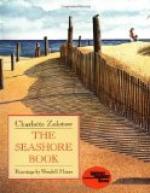You will not be able to see the mouth, however, which is inside the shell. It is fitted with moving parts, and feelers, like the mouth of a crab. Also, the Barnacle has a good set of teeth to grind its food. It has no real eyes, having no use for them. Of what use are eyes to an animal standing on its head in a small dark shell! Now and then it casts its coat (like the Crab and Shrimp). The old coat is rolled up and thrown away outside the door.
Now comes the strangest thing of all. As a baby, the Barnacle is a free swimming creature. It has three pairs of legs, a tail, a useful mouth, and one eye. After kicking about in the sea for some time, and changing its skin, it changes its shape entirely. It now looks more like a tiny mussel. It has two little “shells,” two eyes, legs, and feelers. Now its swimming days are nearly over, and it must settle down. It gives up eating, and roves about looking and feeling for a place to settle on.
Finding a suitable spot, the little animal stands on its head. Then a kind of glue is formed, which fixes it for life to that place, head down. The two shells and the two eyes are now thrown off. The Barnacle quickly builds up a shelly house, and, after a life of adventure and change, becomes a fixed Barnacle for the rest of its days.
For many years people knew little of this strange animal. All its wonderful changes, and the way its body is made, tell us plainly that the Barnacle is actually first cousin to the Crab, Lobster, Shrimp and Prawn! It belongs to the class known as the Crustacea; but, for some reason or other, it has chosen to live its grown-up life fixed to a rock.
EXERCISES
1. How does the Shrimp swim?
2. Of what use are Shrimps and Prawns in the sea?
3. How can you tell a live Shrimp from a live Prawn?
4. How does the Barnacle obtain its food?
5. Give the names of five crustaceans.
LESSON VI.
PLANTS OF THE SHORE.
To pick a bunch of gay flowers you would look in the fields and hedge-rows, and not by the sea. Flowers, as you know, love moist soil, and not dry sand; and, like us, they prefer one food to another. Sand they do not like, and salt is a poison to them. Both of these are enemies to plant life.
Also, flowers choose sheltered spots. They do not like rough winds, and the glare of the sun shrivels them up. Yet there are plants with pretty flowers to be found by the sea, and many others with small, dull flowers. These seaside plants have to fight for their lives. The dry, shifting sand, and the salt spray, are enough to kill them, you would think. They have no shelter from the strong sea wind, nor from the fierce glare of the summer sun. The puzzle is, how do they live among so many enemies? For you know that the flowers of the field would at once die if you planted them in salt and sand. They would starve to death.




